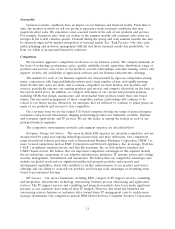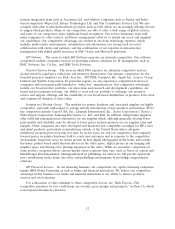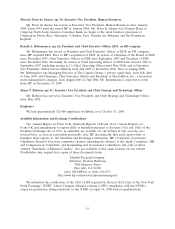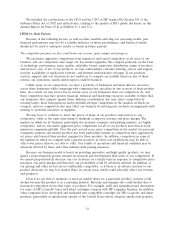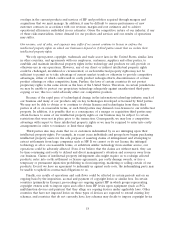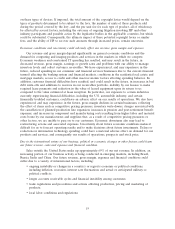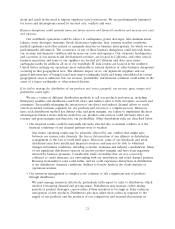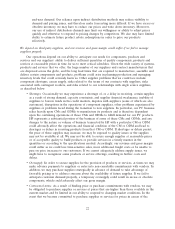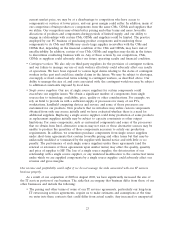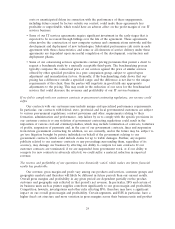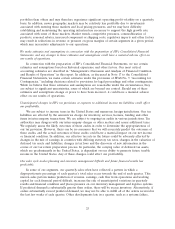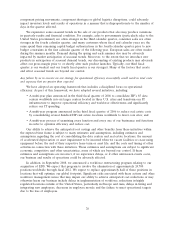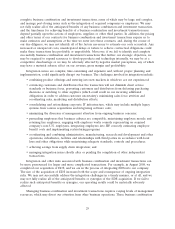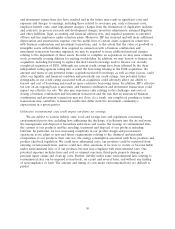HP 2008 Annual Report Download - page 27
Download and view the complete annual report
Please find page 27 of the 2008 HP annual report below. You can navigate through the pages in the report by either clicking on the pages listed below, or by using the keyword search tool below to find specific information within the annual report.chain and result in the need to impose employee travel restrictions. We are predominantly uninsured
for losses and interruptions caused by terrorist acts, conflicts and wars.
Business disruptions could seriously harm our future revenue and financial condition and increase our costs
and expenses.
Our worldwide operations could be subject to earthquakes, power shortages, telecommunications
failures, water shortages, tsunamis, floods, hurricanes, typhoons, fires, extreme weather conditions,
medical epidemics and other natural or manmade disasters or business interruptions, for which we are
predominantly self-insured. The occurrence of any of these business disruptions could seriously harm
our revenue and financial condition and increase our costs and expenses. Our corporate headquarters,
and a portion of our research and development activities, are located in California, and other critical
business operations and some of our suppliers are located in California and Asia, near major
earthquake faults. In addition, all six of our worldwide IT data centers are located in the southern
United States, making our operations more vulnerable to natural disasters or other business disruptions
occurring in that geographical area. The ultimate impact on us, our significant suppliers and our
general infrastructure of being located near major earthquake faults and being consolidated in certain
geographical areas is unknown, but our revenue, profitability and financial condition could suffer in the
event of a major earthquake or other natural disaster.
If we fail to manage the distribution of our products and services properly, our revenue, gross margin and
profitability could suffer.
We use a variety of different distribution methods to sell our products and services, including
third-party resellers and distributors and both direct and indirect sales to both enterprise accounts and
consumers. Successfully managing the interaction of our direct and indirect channel efforts to reach
various potential customer segments for our products and services is a complex process. Moreover,
since each distribution method has distinct risks and gross margins, our failure to implement the most
advantageous balance in the delivery model for our products and services could adversely affect our
revenue and gross margins and therefore our profitability. Other distribution risks are described below.
• Our financial results could be materially adversely affected due to channel conflicts or if the
financial conditions of our channel partners were to weaken.
Our future operating results may be adversely affected by any conflicts that might arise
between our various sales channels, the loss or deterioration of any alliance or distribution
arrangement or the loss of retail shelf space. Moreover, some of our wholesale and retail
distributors may have insufficient financial resources and may not be able to withstand
changes in business conditions, including economic weakness and industry consolidation. Many
of our significant distributors operate on narrow product margins and have been negatively
affected by business pressures. Considerable trade receivables that are not covered by
collateral or credit insurance are outstanding with our distribution and retail channel partners.
Revenue from indirect sales could suffer, and we could experience disruptions in distribution
if our distributors’ financial conditions, abilities to borrow funds in the credit markets or
operations weaken.
• Our inventory management is complex as we continue to sell a significant mix of products
through distributors.
We must manage inventory effectively, particularly with respect to sales to distributors, which
involves forecasting demand and pricing issues. Distributors may increase orders during
periods of product shortages, cancel orders if their inventory is too high or delay orders in
anticipation of new products. Distributors also may adjust their orders in response to the
supply of our products and the products of our competitors and seasonal fluctuations in
21


